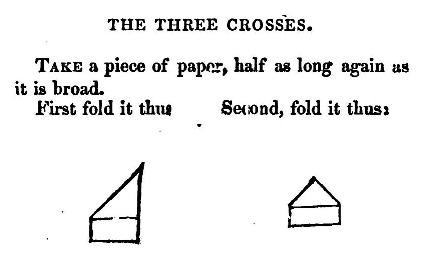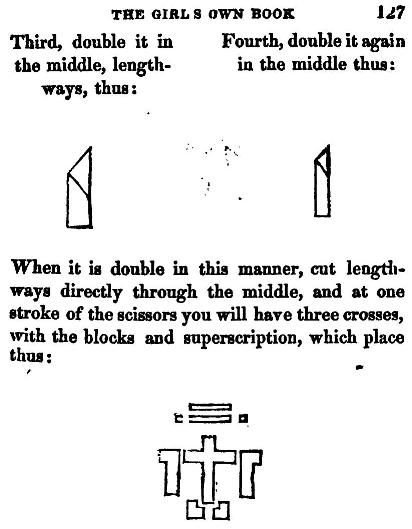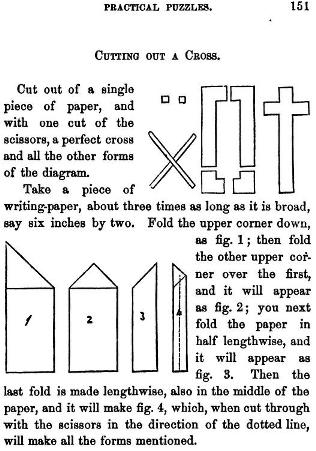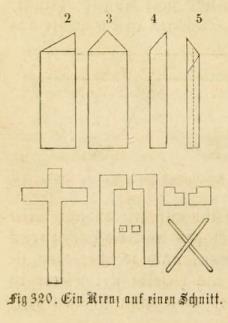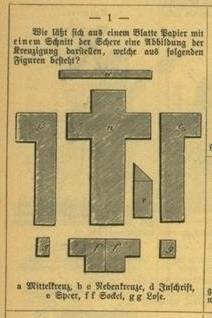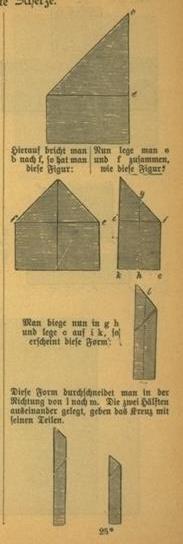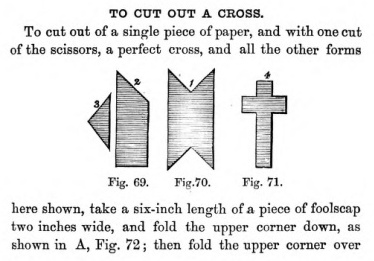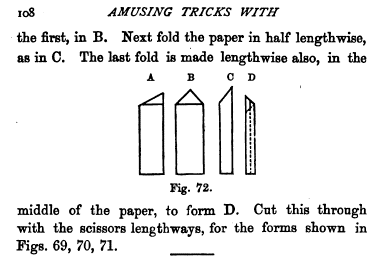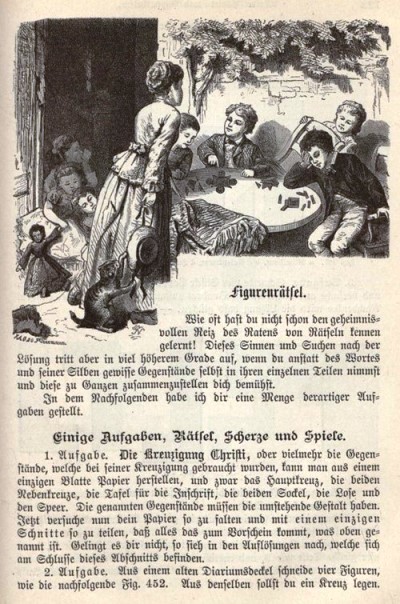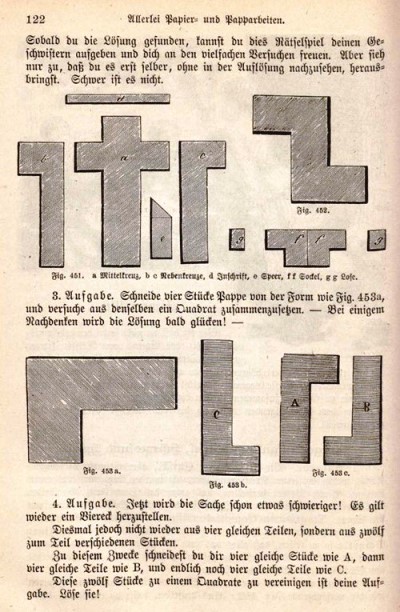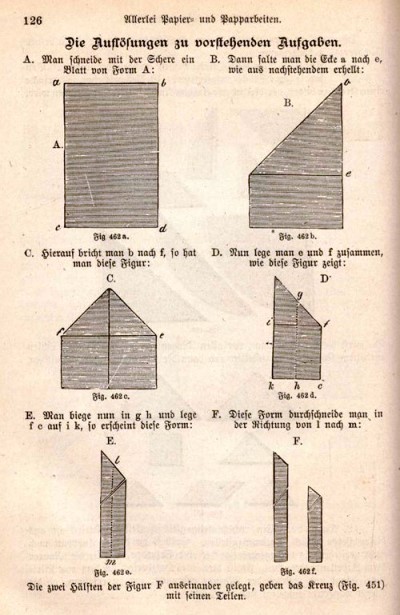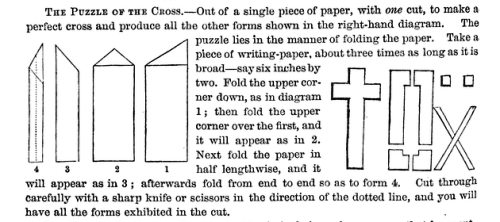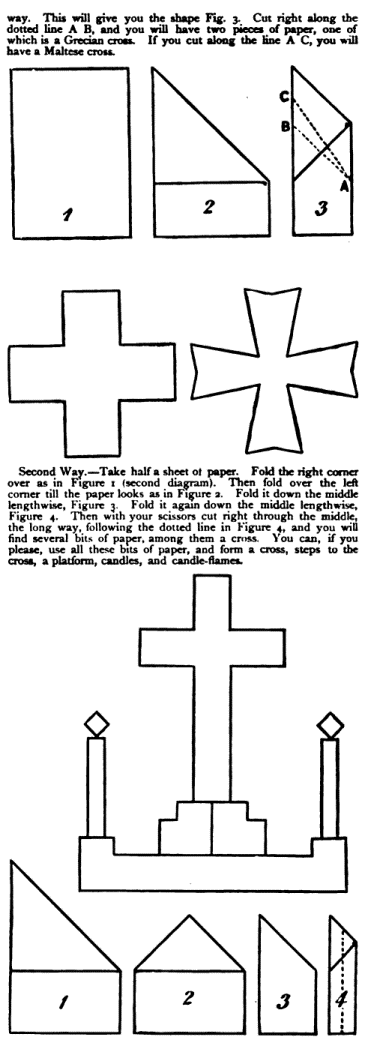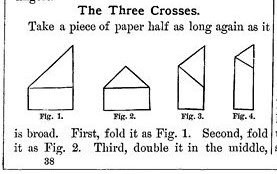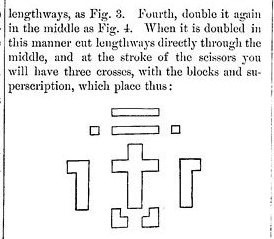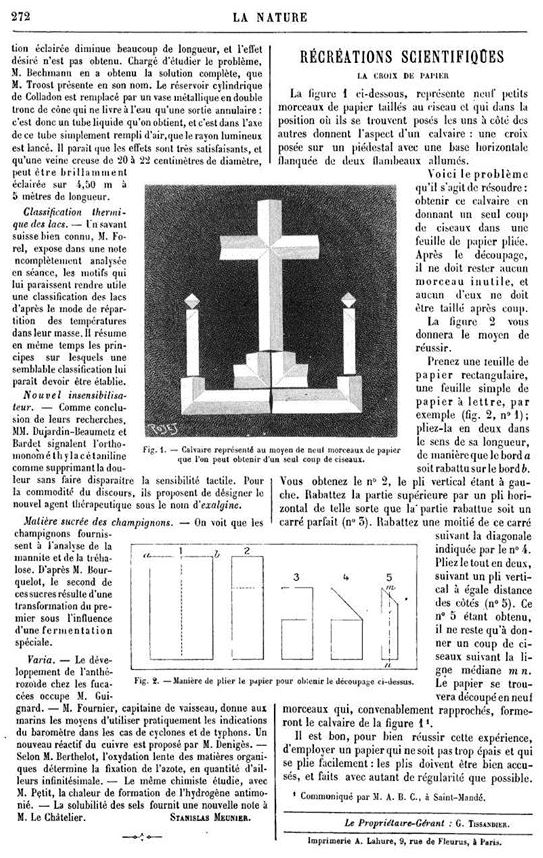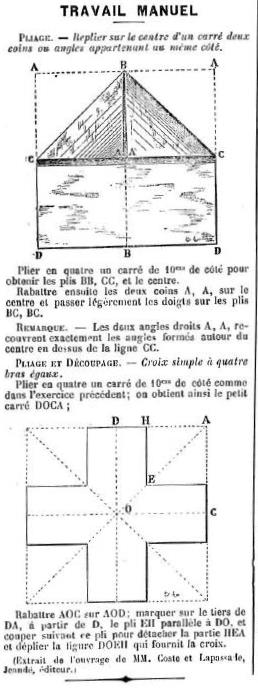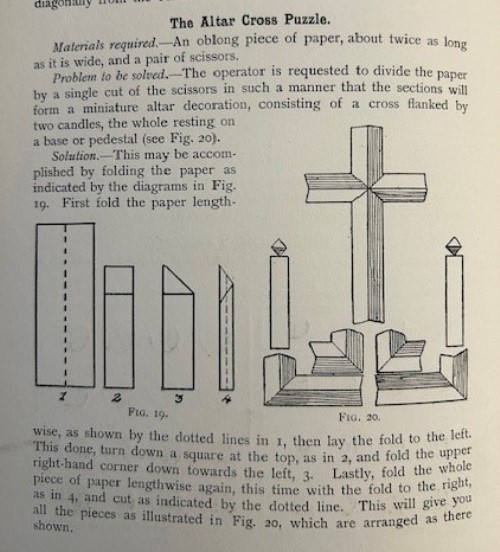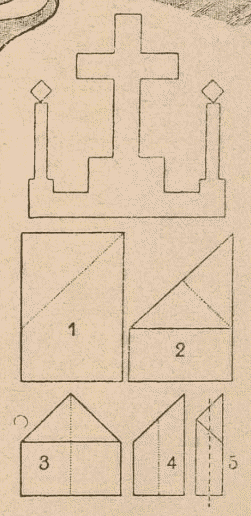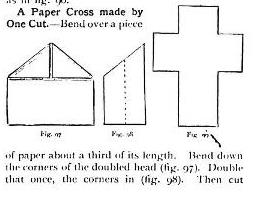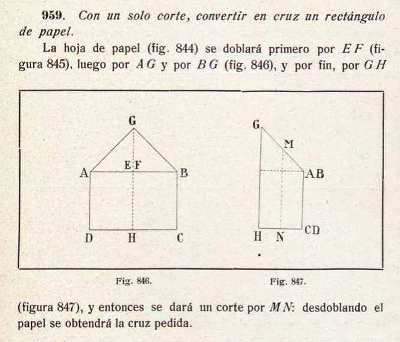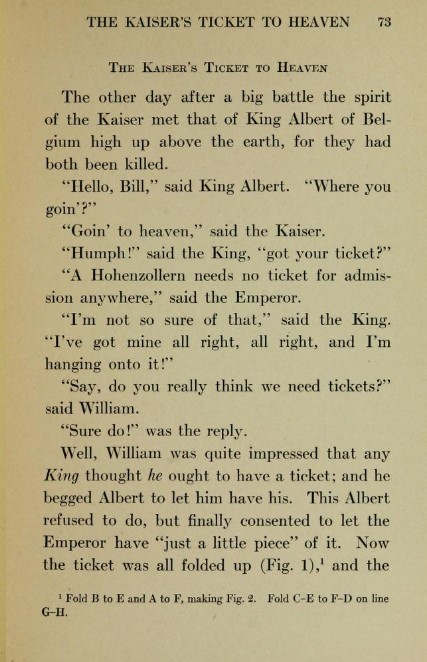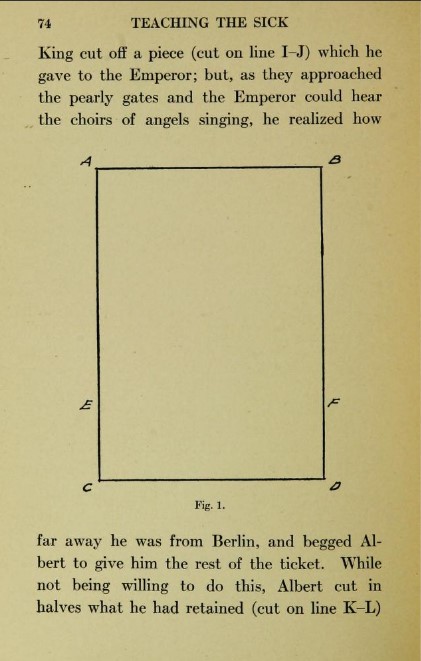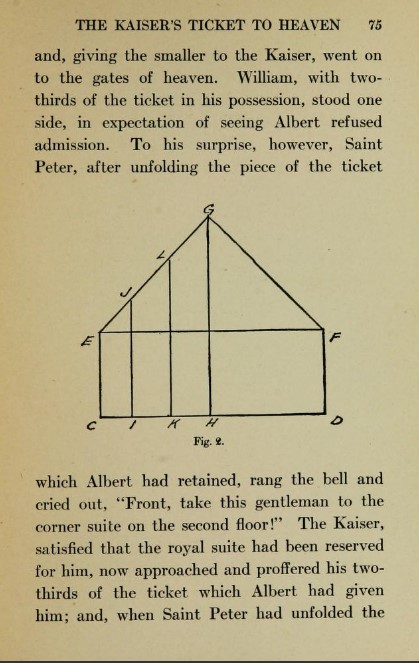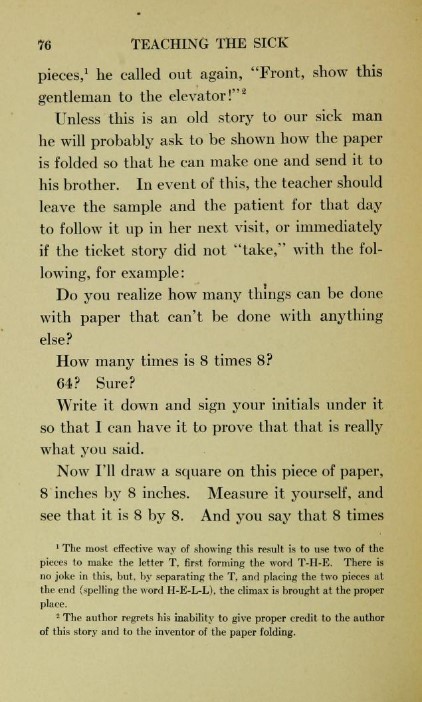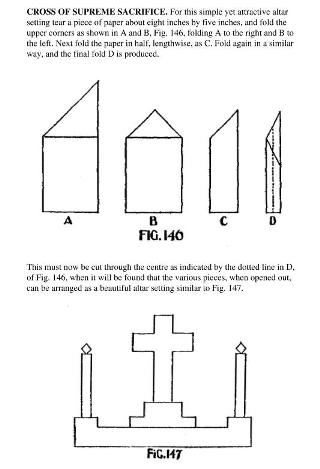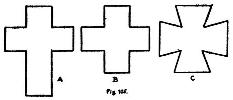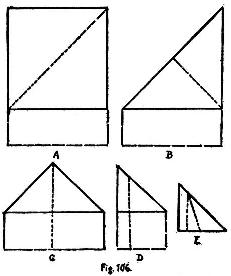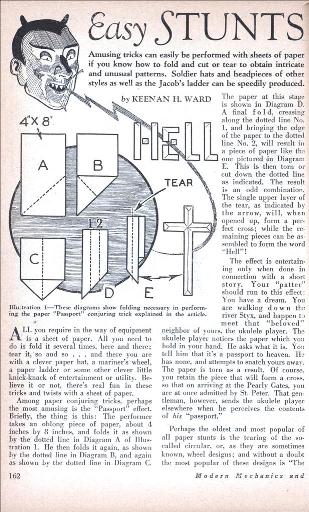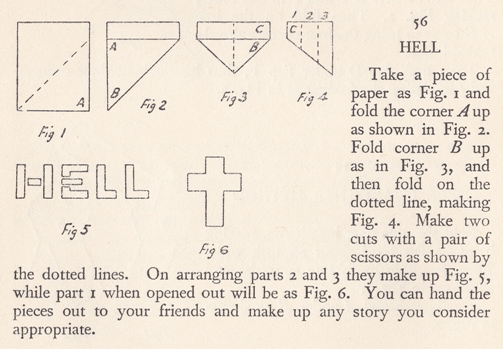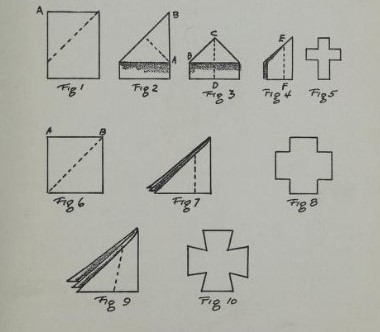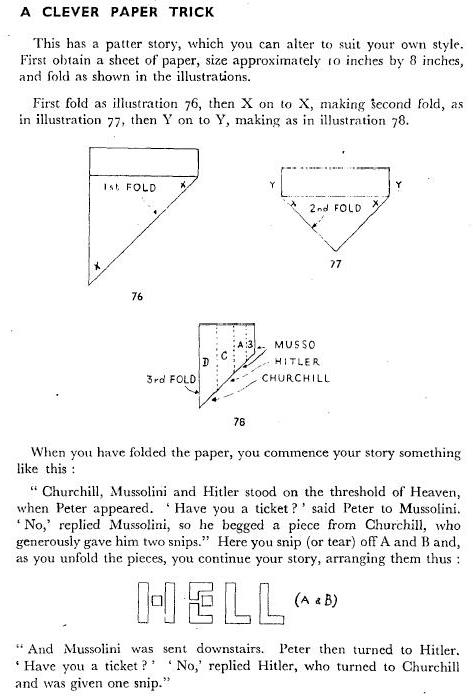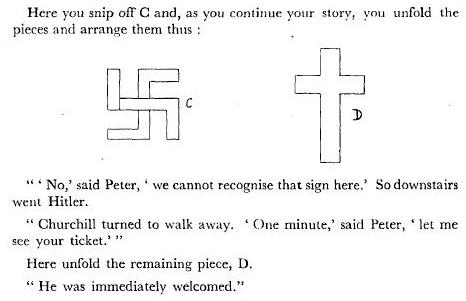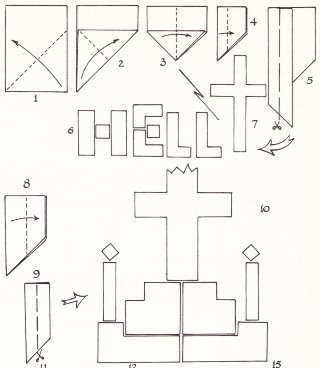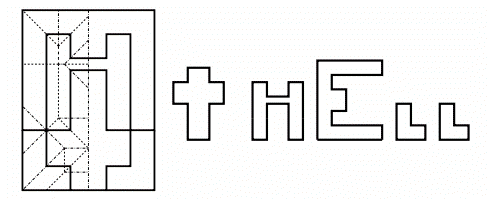| The Public Paperfolding History Project
Last updated 14/3/2024 x |
|||||||
| The Fold and One Cut Latin and Greek Crosses / Altar / Ticket to Heaven | |||||||
| This
page is being used to collect information about the
history of the Fold and One Cut Latin and Greek Crosses
and the Altar / Ticket to Heaven / Hell effects based
upon them. Please contact me if you know any of this
information is incorrect or if you have any other
information that should be added. Thank you. This is one of the most interesting fold and cut designs in terms of its continued evolution throughout the years. ********** 1833 As far as I know the first appearance of this effect in the historical record is in 'The Girl's Own Book' by Lydia Marie Child, which was published by Clark Austin and Co in New York in 1833. The effect is presented as a way to make Three Crosses and the leftover pieces are arranged to add 'blocks and superscription' to the design to form a calvary.
********** 1859 The same effect appears in 'The Boy's Own Toymaker' by Ebenezer Landells which was published in 1859 by Griffin and Farran in London and Shephard, Clark and Brown in Boston. In this case the pieces are not arranged to form a calvary but a cross and two other geometrical arrangements. Theb purpose of the othyer arrangements is not clear.
********** 1863 A similar version appears in 'Spielbuch fur Knaben' by Hermann Wagner, which was published by Verlag von Otto Spamer in Leipzig in 1864, although the foreword is dated May 1863, which argues that the book was complete at that date.
********** Variations of the effect also appear: 1865 In 'Spielbuch fur Madchen' by Maria Leske (a pseudonym of Marina Krebs), which was published by Verlag von Otto Spamer in Leipzig in 1865.
********** 1872 In 'Hanky Panky', a book of magical effects, puzzles, recreational mathematics and other amusements, by W H Cremer, Jun, which was published by John Camden Hotten in London in 1872.
********** 1874 A version of this design, very similar to that which appeared in 'Spielbuch fur Madchen' by Maria Leske in 1865, and titled 'The Crucifixion of Christ', appears in 'Spiel und Arbeit' by Hugo Elm, which was published by Verlag und Drud der Otto Spamer in Leipzig in 1874. The text says, roughly, 'The crucifixion of Christ, or rather the objects used in his crucifixion, can be made from a single sheet of paper: the main cross, the two secondary crosses, the plaque for the inscription, the two pedestals, the lots, and the spear.'
********** 1880 In the new edition of 'The Boy's Own Book', 'thoroughly revised and considerably enlarged', which was published in London by Crosby, Lockwood and Co in 1880.
********** 1881 In a reader's letter in the Letterbox column of the January 1881 issue of the American children's magazine St Nicholas.
********** 1887 The effect appears as 'The Three Crosses' in 'The Home Book for Very Little People' by J H Vincent, which was published by Phillips and Hunt in New York in 1887.
********** 1889 In the 9th March 1889 issue of the French magazine 'La Nature', where it is presented as a puzzle.
********** 1892 A basic version of the fold and one cut latin cross design appears in the 30th October 1892 issue of 'Journal des Instituteurs'. This is extracted from the book 'Le Travail Manuel a L'ecole Primaire, by M. Coste et J. Lapassade, which had been published in 1887.
********** 1904 As 'The Altar Cross Puzzle' in The Book of Indoor Games' by J K Benson, which was published by C Arthur Pearson Limited in London in 1904.
********** 1906 In Les Bon Jeudis by Tom Tit, published in Paris in 1906 by Librairie Vuibert.
********** 1910 As 'A Paper Cross made by One Cut' in 'Handicraft in the School', which was issued in four volumes by Gresham Publishing in London in 1910.
********** 1918 In 'Ciencia Recreativa' by Jose Estralella, which was published by Gustavo Gili in Barcelona in 1918. (Section 960 explains how to create a cross with equal arms by beginning with a square.)
*********** 1919 In 'Teaching the Sick: A Manual of Occupational Therapy and Reeducation' by George Edward Barton, which was published by W B Saunders Company in Philadelphia and London in 1919, where it is called 'The Kaiser's Ticket to Heaven'.
********** 1920 In 'Paper Magic' by Will Blyth, which was published by C Arthur Pearson in London in 1920, under the title 'Cross of Supreme Sacrifice' which formed part of a rather jingoistic presentation entitled 'Gains of the Great War.'
********** 1922 In 'Houdini's Paper Magic' published by E P Dutton and Company of New York in 1922. The effect is titled 'Three Crosses'. Nothing is said about use of the various leftover pieces. The Greek Cross and the Maltese Cross are obtained from a folded square in a similar way.
********** 1929 An article by Keenan H Ward which included a different presentation of this effect, in which the various spare pieces are arranged to form the word 'HELL', appeared in the December 1929 version of 'Modern Mechanics' magazine.
I learned of this reference from john.maloney.org/peterandpaul.htm. ********** 1932 The Hell version also appeared in 'Winter Nights Entertainments' by R M Abraham, which was first published by Constable and Constable in London in 1932.
********** 1939 'Fun with Paper' by Joseph Leeming, which was published by Spencer Press Inc in Chicago in 1939, contains diagrams for the The Fold and One Cut Latin and Greek Crosses
********** 1944 'The Phoenix' issue 62 contained an effect titled 'Pieces of Fate' by L Vosburgh Lyons which is described as 'folding and cutting a piece of paper into a circle, a swastika, the words hell and peace are formed, themed to the WW2', which sounds like a version of the same effect. (Information from conjuringarchive.com) ********** 1947 An interesting version using three cuts (the additional cut creates the swastika) can be found in 'Willane's Wizardry' by Willane, which was pubished by ARCAS, in London, and has a foreword dated 1947. It is also a good example of a paperfold / magical effect used as political propaganda, very much reflecting its time. Many people nowadays would find it strange that Churchill did not join the others on the downward journey. Information from Edwin Corrie.
********** 1960 'Paper Folding Fun' by Robert Harbin, which was published by Oldbourne in London in 1960, contained instructions for two different effects, 'The Passports' and 'The Altar'.
********** 2004 In their paper 'Fold-and-Cut Magic', included in 'Tribute to a Mathemagician', published by A K Peters in 2004, Erik and Martin Demaine describe a method of achieving a similar effect in which the cross and each of the four letters can be cut whole from a rectangle using just one cut. The method of folding the paper to achieve this is necessarily more complicated than the original effect.
********** More recently someone has discovered that the various spare pieces can also be arranged to form the word 'LIFE'. I do not know the date at which this discovery was made or who made it.
********** |
|||||||
